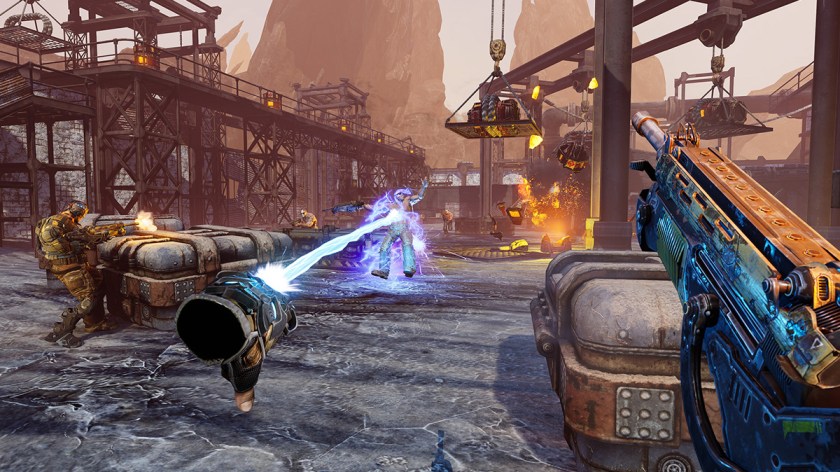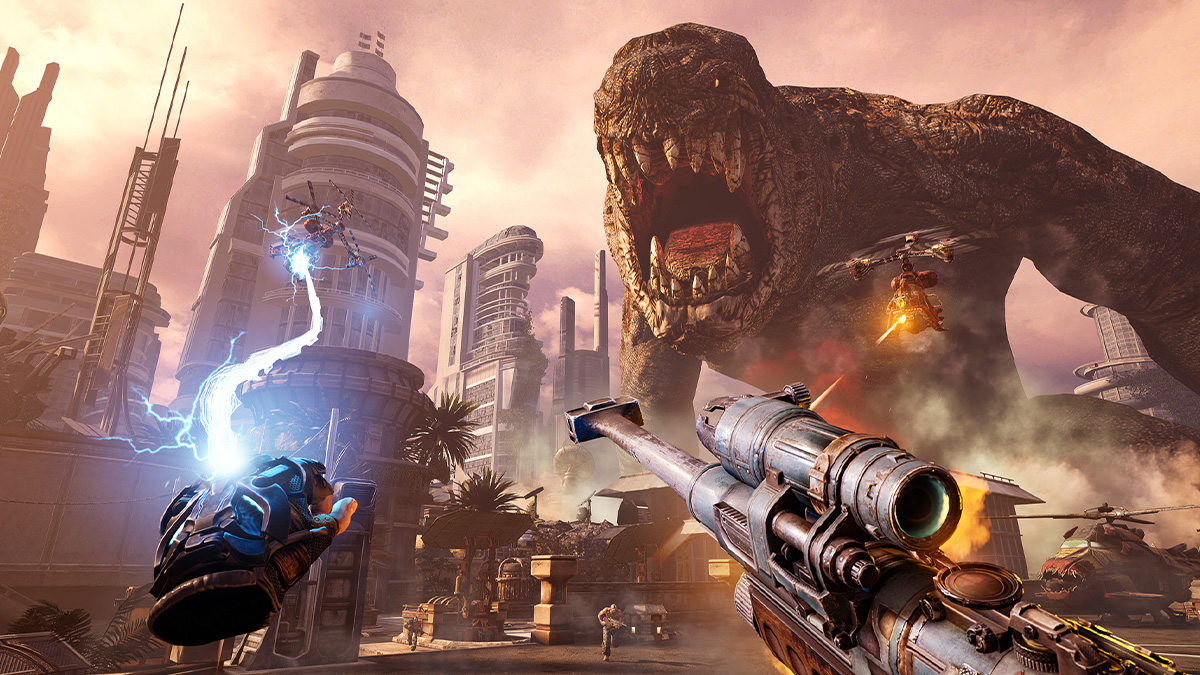When Bulletstorm debuted in 2011, the explosive first-person shooter impressed players with its no-holds-barred action gameplay. The FPS was also a product of its time, as it was both unabashedly crass and bombastic. So when I first heard about Bulletstorm VR, I was excited to see how the game’s over-the-top campaign would translate to virtual reality.

Upon diving into the game for the first time, Bullestorm VR gives players many customization options to shape their in-game experience. For instance, those worried about motion sickness can use the “snap” camera, which allows you to turn your vision in small increments. Though I personally preferred the “smooth” camera as it’s, in my opinion, more immersive. It feels like you are really standing in the game’s world.
One of the first things that really stood out to me in Bulletstorm VR was the controls. Instead of mapping everything to buttons, the game really goes out of its way to break apart every single action so that it becomes a physical experience. For example, when I wanted to use my gun, I had to reach down to the holster on my right hip and lift it up to use it. Similarly, when I needed to reload my weapon, I had to take my left Meta Quest 3 controller and reach down to my left hip to grab my ammo. And I literally mean grab it.
The game makes you squeeze your controller so you wrap your fingers around the ammo, and then you have to shove it into the bottom of your gun (which you hold with your right controller). If you let go of squeezing your controller, your character will actually drop your gun on the ground as well. So this is a very tactile experience, and the game goes a long way to make you constantly feel like you are physically present in the game.

Unfortunately, VR mapping hasn’t advanced enough that it can easily track your legs fully, so Bulletstorm’s infamous kicking mechanic is relegated to a button press instead. Similarly, the game’s iconic sliding mechanic is also mapped to a button hold in the opposite direction of your kick. However, with everything you already have to juggle in VR physically, this was probably for the best. While the Meta Quest 3 is wireless, I can’t imagine how hectic things would have gotten had I actually slid or crouched on the ground, not to mention the damage I would have done to my room!
One of the biggest things I struggled with in Bulletstorm VR is the game’s combat. Specifically, how weightless guns feel in the game. This could just be my experience, but I felt that the game didn’t have enough feedback or punch to the shooting. This results in gun battles feeling disconnected. The best way I can describe it is you are pointing a floating gun and then shooting in a general direction. But it never feels like you are hitting anything, as enemies don’t react as expected. Or, to put it another way, I didn’t know half the time if I was even hitting my enemies and only found out when they would fall over incapacitated.
Thankfully, combat expands in a massive way fairly early into the campaign when you unlock the Energy Leash mechanic. The weapon is set to your left hand, allowing you to send an electric whip. This is where the game really shines in VR. Although the game offers two modes, I suggest people try the motion controls instead of the aim setting. Within seconds, I was whipping my hand down in the air and slapping enemies across the map. What makes this really fun is that you snatch enemies out of the air and immediately bring them to you.

Anytime you use your leash on an enemy, they will freeze in the air in slow-motion for a few seconds, letting you use your gun in your right hand to load into them. The game’s kicking mechanic also sends your foes flying in slow motion. So, if you time all this right, you can whip and kick enemies all over the level. It’s a lot of fun when it all gels together. Although I will say I think combat will be a bit of a learning curve for some players. If you struggle to use both your left and right hand simultaneously, combat can take a bit to get used to, as you are responsible for physically combining every action. I can’t tell you how often I would set up an epic combo by whipping an enemy into the air, only to fumble it when I struggled to grab the ammo clip off my left hip and shove it into my gun fast enough. But when combat works, it’s a lot of chaotic fun.
The gameplay improves even further when you unlock the trickshot feature. In Bulletstorm VR, your moves and kills can earn you points based on how stylish your combo is. This is another feature that I think works really well in VR. For instance, it’s incredibly satisfying to whip an enemy across the level and slam them into a cactus or fence. Sure, you could do that in the original game, but there is something much more satisfying here when you look at the enemy in the face as they are slammed into a gate a few feet away from you. I also think the immersive nature of VR allows you to use this feature more strategically as you get a better sense of the environment and where you can throw your foes.
While I appreciate all of the efforts that went into making combat a physical experience, I do think that, ultimately, it feels a little clunky. This could just be my own experience level in VR. Maybe a more veteran player who is better at juggling multiple tasks would pull it off a bit more with ease. But at least for me, combat always felt like a handful of moving parts that never would quite gel together smoothly. And in all fairness, the hectic nature of Bulletstorm’s combat was always going to be tough to translate. After all, in the original game, you were sliding around the level at breakneck speed while quickly smashing one enemy before jumping to the next. I feel like that visceral speed and thrilling action is a little lost here as you are left juggling each action.

Another thing that stood out to me while starting up Bulletstorm VR is its graphics. This game is very much a faithful adaptation of the original game, so players shouldn’t expect a massive overhaul for virtual reality. It literally feels like you are stepping into a 2011 game and being able to walk around in its engine. As someone who loves retro games, I actually found that charming. But if you expect more realism from your VR experiences, this might be a major sticking point for you. This really becomes noticeable as you progress through the campaign and are thrust into action-heavy levels. Muddy textures and blocky environments are pretty common here. But as I said above, this is a 2011 game, so as long as you walk into this expecting Bulletstorm, but in virtual reality, it might not bother you.
So the question I was left asking myself was, is the VR version a superior version of Bulletstorm? As of right now, I would say no. But if you are a fan of the original game, I do think this is a unique spin on a classic FPS that allows you to experience it in a completely new way. Although the graphics and core elements of the campaign are the same, the gameplay changes are a massive difference that moves the game into a more physical experience.
Bullestrom VR is now available on the Meta Quest and VR headsets via Steam.


Published: Jan 21, 2024 12:00 pm